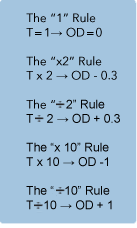

Optical Filters FAQs
Here we have provided comprehensive lists of commonly asked questions regarding our Semrock optical filters and related applications. This information is designed to support your inquiries, but if you don’t find the answers you are looking for we encourage you to contact us for further assistance.
Please use the sort buttons in the left navigation to navigate between questions and answers that are specific to Optical Imaging Systems, Fluidics, Cameras, Microfluidics, our Webstore, and Engineering Partnership.
What is optical density?
Optical Density (OD) is a convenient tool to describe the transmission of light through a highly blocking optical filter (when the transmission is extremely small). OD is defined as the negative of the logarithm (base 10) of the transmission, where the transmission varies between 0 and 1.
OD = – log 10 (T)
or
T = 10 -OD
Through careful optimization of our measurement equipment and methods, Semrock is able to provide some of the best wide bandwidth Optical Density (OD) measurements possible. Below are typical OD noise floor limitations for most of the measurement data shown on this website.
- For wavelengths between 320 and 1120 nm, transmission values near or below 3e-7 (Optical Density 6.5) are measurement noise limited.
- For wavelengths < 320 nm and between 1120 - 1500 nm, transmission values near or below 3e-6 (Optical Density 5.5) are measurement noise limited.
- For wavelengths > 1500 nm, transmission values near or below 1e-5 (Optical Density 5.0) are measurement noise limited.
Also, for some filters and/or some blocking wavelength ranges, measurements with a noise floor of only about OD 4 are shown.



